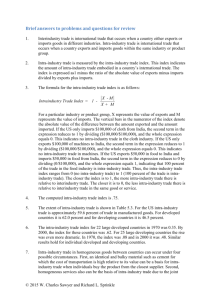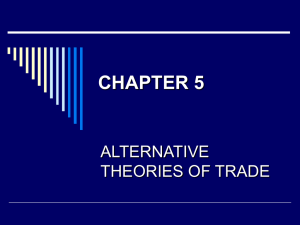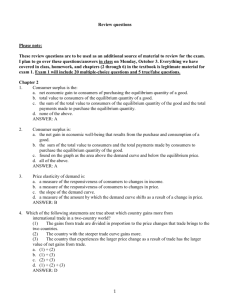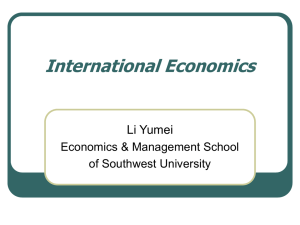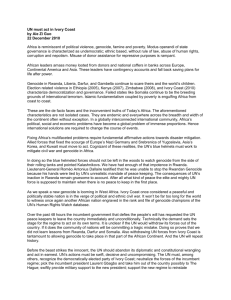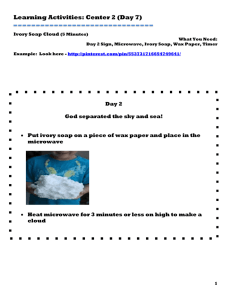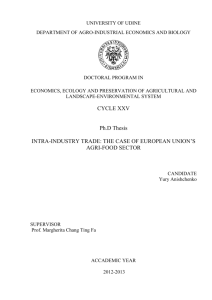Analysis of International Trade of Ivory Coast: assessment of Intra
advertisement
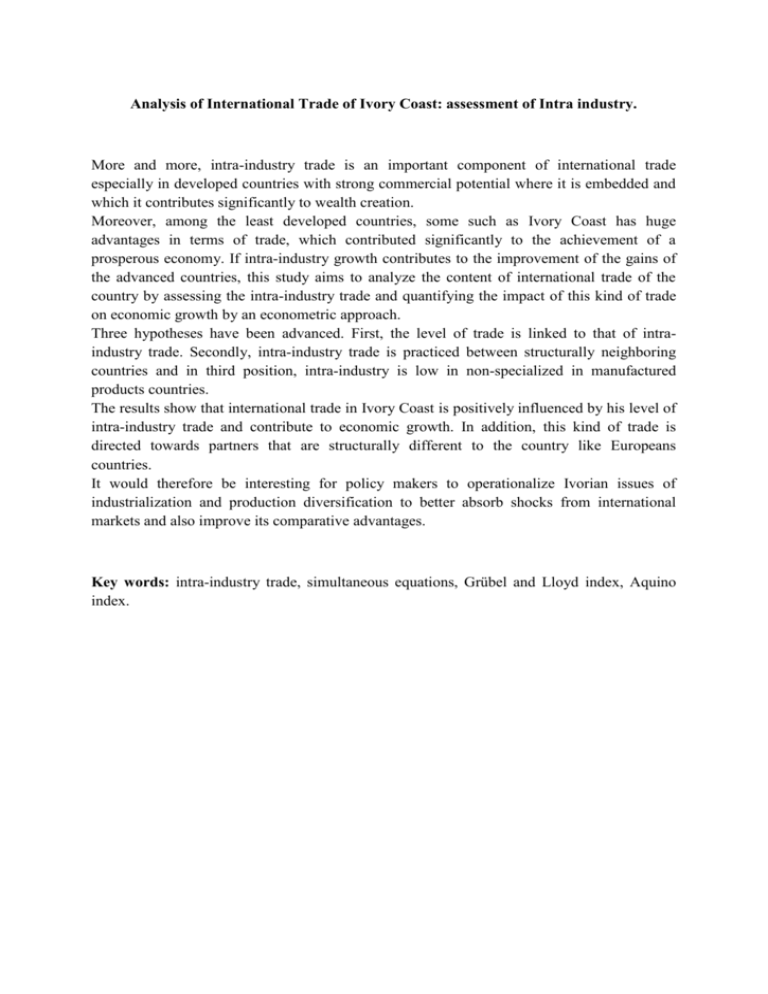
Analysis of International Trade of Ivory Coast: assessment of Intra industry. More and more, intra-industry trade is an important component of international trade especially in developed countries with strong commercial potential where it is embedded and which it contributes significantly to wealth creation. Moreover, among the least developed countries, some such as Ivory Coast has huge advantages in terms of trade, which contributed significantly to the achievement of a prosperous economy. If intra-industry growth contributes to the improvement of the gains of the advanced countries, this study aims to analyze the content of international trade of the country by assessing the intra-industry trade and quantifying the impact of this kind of trade on economic growth by an econometric approach. Three hypotheses have been advanced. First, the level of trade is linked to that of intraindustry trade. Secondly, intra-industry trade is practiced between structurally neighboring countries and in third position, intra-industry is low in non-specialized in manufactured products countries. The results show that international trade in Ivory Coast is positively influenced by his level of intra-industry trade and contribute to economic growth. In addition, this kind of trade is directed towards partners that are structurally different to the country like Europeans countries. It would therefore be interesting for policy makers to operationalize Ivorian issues of industrialization and production diversification to better absorb shocks from international markets and also improve its comparative advantages. Key words: intra-industry trade, simultaneous equations, Grübel and Lloyd index, Aquino index. 1. Introduction Context World trade has continued to grow significantly over time. Indeed, the commercial transactions of the globe are grown from U.S. $ 292 billion in 1970 to U.S. $ 4252 billion in 1993, an increase of 1356% in 20 years. The index of the value of exports (2000 = 100) rose from 100.4 in 2002 to reach 249.5 in 2008, while the index of the value of imports grew by 146% over the same period. Moreover, if the trade volumes reach proportions never seen before, this will not happen without change in contemporary business practices. Thus, over 70% of current business transactions consist of exchanges between similar products, ie products of the same branch. In addition, the African continent as a whole has struggled to keep up this new dynamic unlike other economic centers. In 2007, for example, the share of exports of African goods in world exports totaled around 3.1% and 2.5% for imports, while in Europe represented the same year 42.51% of world exports and 43.43% of world imports. Ivory Coast, one of the heavyweights of the African trade, the world's leading exporter of cocoa, is not in rest of these mutations. Because, of the trade, the country has experienced an average growth rate of 6.8% between 1965 and 1980, which was described as the "Ivorian miracle". This has enabled the country to seriously consider the development. However, the underperformance recorded during the years following challenge on the possible causes of this situation. The country's external debt grew significantly constrains development mechanisms. Problem Besides the fact that the global economy has not been in recent years in favor of countries, because of falling commodity prices, rising dollar and strong competition internationally for its main export product, policy trade of Ivory Coast does show that she not fit easily with the new forms of exchange in the world, mainly in intra-industry trade. In other words, what could be the impact of this type of trade on the country economic growth? Study objectives General objective The aim of our study is to analyze the ivorian trade and assess its intra-industry trade practice through its impact on the economy. Specific Objectives We assume this general purpose into two specific objectives : - The analysis of the cross-flow of products in the branches (importance / assessment / estimate) - The study of the relationship between trade and intra-industry trade (based on an econometric approach). Hypothesis As part of the econometric analysis, we assumed three hypothesis: H1: Foreign trade increases with the level of intra-industry trade. H2: The level of intra-industry trade depends on the characteristic of the commercial partner0 H3: intra-industry trade remains low in not specialized manufactured savings products. 2. Literature Review Intra-industry trade: a theoretical review The traditional analysis of international trade that developed by Ricardo and HOS ( Heckser , Ohlin , Samuelson ) show that, most countries have different factor endowments , plus their specializations will be complementary and therefore cross- trade products will be observed , what could be called a north-south trade. However, the situation after 1960 reveals that there were strong currents of cross trade in similar products between countries with fairly similar factor endowments , mainly from northern countries . Thus, authors such as Linder shows through his “theory of representative demand” that the share of intra branches is higher between countries that have very strong similarities of factor endowments . Indeed , for the author a good may be exported only if it is first subjected to strong domestic demand and the property is exported to a country with likely levels living relatives. In addition, “demand theory difference” of Lassudrie - Duchène states that even if the intra-industry trade is growing between countries with most similar endowments , it remains that the products are not exactly the same . These have potential for differentiation resulting from their brand , their specific qualities , etc. that will create the conditions intra-industry trade . This logic of differentiation can be expressed only in countries with a high standard of living , which explains that the intra-industry trade takes place mainly among Developing Countries . After that, Posner introduces technological progress in the analysis of the phenomenon. For him, it characterizes the comparative advantages of a country. Thus , developed countries are exporting products with intensive technology - , while developing countries mainly export only commoditized products. These studies will be supported by other authors such as Krugman and Vernon with his theory of the life cycle of a product. Intra-industry trade: an empirical review Two studies were mainly operate in support of this part of the study . The first , led by Phan Duc Gaussens and clear Claude sheds light on a number of aspects of intra-industry trade including the identification of the determinants of the relationship between them and international capital movements, identified in the form of foreign direct investment (FDI). This study on the analysis of intra-industry trade is made on a wide range of products , defined at the finest in the classification of the five-digit of International Trade Classification Type (ITCT) revision , and for which a calculation on more aggregated data ( nomenclature three-digit SITC revised ) reveals an important cross trade . The results can be given in three points mainly : First, the existence of an international intra -industry trade is focused on differentiated products , characterized by a concentration of large and balanced bilateral trade , which tends to exclude the recovery of a possible hierarchy between trading partners in the orientation of the flow of goods. Secondly it appears clearly that low dispersion consumption patterns reinforced by economic proximity has a positive influence on the development of intra -industry trade and Third, the complementary nature of direct investment crossed towards international trade in differentiated products does exist . However the impact of factor endowments , although it seems to exercise the right way , could not be precisely identified . The second study was conducted by Hatem et al and aims to study the impact of intra-industry trade on the adjustment of employment to verify the hypothesis of low employment adjustment cost ( Smooth Adjustment Hypothesis , SAH). Using the measure of Brulhart , the MIIT , at the expense of Grübel and Lloyd, and using a panel model with fixed effects for the Tunisian case the period between 1983 and 2000 , they show two important results.The first implies that the best indicator to study the relationship between intra-industry trade and adjustment of employment is an index of Brulhart noted A and the second is that the hypothesis of poor fit is checked. In fact, a 1% increase in the marginal intra -industry trade ( CIBm ) leads to a 0.04% decrease in the unemployment rate . 3. Analysis of export and import flows of Ivory Coast Exports: the first 5 products exported Ivorian exports an uptrend in our study period. They rose nearly 6 bn1 dollars to around 10 dollars bn in 2009. Analysis of the products exported by the Ivory Coast in recent years at the 2-digit is contained in the following table: 1 billions Table 1: The top 10 products (code with 2 digits) of Ivory Coast (in percentage of its total exports). Code 18 27 87 product Cocoa and cocoa preparations Mineral fuels, mineral oils, products of their distillation Vehicles, tractors, cycles and other vehicles,etc. 2004 2005 2006 2007 2008 2009 33,17 28,43 24,98 27,33 28,71 36,23 18,52 27,73 36,87 32,59 37,1 29,37 12,15 2,83 3,95 4,61 5,14 3,37 89 Wood, charcoal and wood products 5,25 4,59 2,27 0,05 0,99 3,3 8 Edible fruit and nuts, peel of citrus fruit or melons 3,65 3,52 3,59 3,56 3,46 3,13 Source : International Trade Center, our calculations Then, we see that the group of products' s cocoa and its preparation "is an important part of exports followed the" mineral fuels, etc.. Exports: the first 5 partners importers of the products exported by the country in Africa Table 2: the 5 major African importers of Ivorian products (% of total exports of Ivory Coast) Importers 2004 2005 2006 2007 2008 2009 Nigéria 27,54 26,76 24,53 24,96 19,95 23,32 Burkina Faso 10,65 10,69 12,39 13,18 13,14 12,43 Ghana Mali Sénégal 8,97 8,04 5,62 6,85 7,33 6,09 6,63 9,36 3,99 6,29 11,52 4,92 14,38 10,4 5,23 18,38 8,7 4,77 Source : International Trade Center, our calculations In the top 5 in Africa, Nigeria stands essentially, followed by Burkina Faso. Products exported to these remain "oilseeds" and others. Regarding the European partners, France ranks first with nearly 40% of Ivorian exports. Imports: the first 5 products imported by Ivory Coast Like exports, imports grew by 2004 to 2008 from 4 bn U.S. dollars to nearly 8 bn before falling around 7 bn in 2009. In addition, the main products imported by the country are given in the following table: Table 3: The 5 main imports in % of total imports of Ivory Coast Code Libellé produit 2004 2005 2006 2007 2008 2009 27 Mineral fuels, mineral oils, products of their distillation 23,2 28,03 31,78 30,17 35,71 25 87 Vehicles, tractors, cycles and other vehicles, etc 18,24 14,42 11,59 10,89 5,22 5,52 10 Cereals 5,94 5,38 6,16 6,25 7,33 10,57 84 Machinery, nuclear reactors, boilers, machinery 6,1 4,79 5,14 6,73 6,6 8,8 4,31 5,1 5,53 4,64 6,45 Machinery and electrical 4,17 equipment, their parts, etc. Source : International Trade Center, our calculations 85 It can be noted that the product groups with code 27 and 87 are both concerned by imports and exports. These imported products come to mainly partners like Nigeria, France, the United States, China. Many of those are involved in import and export flows. There are many reasons to believe that there exists a type of intra-industry trade between Ivory Coast and its partners. In the next section, we try to calculate the index of intra-industry trade of Grubel and Lloyd for the country. 4. Intra-industry trade index computing International trade is composed of two components, one intra-industry exchange and the other, the inter-industry trade.. If Xi represents exports and Mi imports, then we have: with and Ri the intra-industry trade. Based on this distinction, Grübel and Lloyd (1975) propose two measures to assess each country's proportion of total trade, all sectors combined, attributed to the intra-industry trade. The first recorded, calculated for each country the coefficient of intra-industry trade without considering the correction of imbalance in the trade: with and respectively exports and imports of country j for products branche i (i = 1, ..., n branches). is taken the value between 0 and 1 (taking the remarkable value of 2/3 if exports (resp. imports) covers exactly half of imports (resp. exports)) if the country is exclusively importer (or exporter only) for all goods; if the trade balance is achieved for each product. However this index underestimate the importance of intra-industry trade for countries whose trade is not balanced. Hence the was a production of another index recorded adjusted trade imbalance : Moreover, tends to overestimate the importance of intra-industry trade because when the trade balance is in equilibrium, the denominator tends to decrease and consequently introduces a bias towards higher coefficient. So, the two countries with the same have may different if one of them is in surplus (or very deficient) in many branches. Then, Aquino (1978) propose an index which measures the difference in the composition of imports and exports observed for a country: Fj 1 1 n X ij M ij 2 i 1 X . j M . j The index of Aquino takes an intermediate value between and of Grübel and Llyod. The calculations of these three indicators give us the following results: Table 4: The indexs of Grubel-Lloyd and Aquino from 2004 to 2009 2004 2005 2006 2007 2008 B 0,49 0,53 0,47 0,47 0,44 F 0,45 0,53 0,5 0,49 0,48 C 0,58 0,59 0,56 0,52 0,5 2009 0,36 0,4 0,45 Source : International Trade Center, our calculations The results of Aquino (1978) are confirmed. F value is an intermediate value between B (unadjusted index) of Grübel and Lloyd, who has a bias towards lower and C (corrected the imbalance in the trade balance) which tends instead to skew the intra-industry trade to increase. In addition, the coefficients are below 2/3, the Ivorian intra-industry trade is low and poorly developed. In addition, a comparative analysis with other countries allow us to corroborate the previous results. We represent, for the same period of study, the Grübel-Lloyd index of some countries, for comparison: Graph 1: Index B of Grubel and Lloyd of some countries. Source : International Trade Center, our calculations Two blocks are drawn on the graph. The first batch of three countries that find themselves at the bottom of the graph and these are developing countries (or less advanced countries) and other block consists of advanced countries that have indices more than 0.5. This evidence that intra-industry trade is very little developed to the less developed economies. Moreover, it should be noted that the higher the level of disaggregation is fine (eg position of 6, 8 digits), the higher the index decreases and tends to 0. 5. Trade and intra-industry trade: link specification. The model The structuring of relationships we seek to determine leads us to choose the simultaneous equations model for our study variables belong to a set of interrelated equations. According to our assumptions and based on the literature, we use as endogenous variables the opening rate as representative for Foreign Trade (ICE) and Aquino index F (IA) to represent intra-industry trade. In what concerns the exogenous variables, we use the variable on the identity of consumption patterns that we note EIMP where with mi as the part of ivorian imports and mi the average of the major trading partners of Ivory Coast including the top 5 in terms of exports and imports. This variable will check the hypothesis according to which the intra-industry trade of differentiated goods is intensive between countries with similar characteristics or endowments. Then we have the identity of variables that factor endowments EPIB we note that is a mean absolute deviation between the Ivorian GDP and those of its main partners, the indicator of Foreign direct investment (FDI), the indicator economic distance we note idist which take the value 1 if the partner is a member of the Waemu countries and 0 otherwise. This will capture the effect of distance on the Ivorian foreign trade especially in the intra-industry trade. It’s to see if Ivory Coast make trade with the member countries of its economic zone (there we choose West African Economic and Monetary Union WAEMU) instead of advanced countries . And the last variable is GDP. The model IAt 0 1 IDEt 2 IDISTt 3 EPIBt 4 EIMPt 1t ICEt 0 1 IAt 2 IDEt 3 PIBt 2t can be written as: Equations 1 and 2 are over identified, which allows us to apply the double least squares. The estimate under E_views gives the following results: IAt 0, 029712 IDIST 0, 000114 IDE 6, 71.10 08 EPIB 7, 45.10 11 EIMP ICEt 0,689670 IAt 7,97.1006 PIBt 0.000151IDEt Interpretation of results The intra-industry trade of goods is positively related to the slack variables of the economic characteristics of the Ivory Coast and its key partners. The Ivorian intra-industry trade is directed to advanced countries (eg France, Usa) rather than those that have similar structures with him. It also confirms that the positive relationship between intra-industry trade in the distance between the Ivory Coast's main partners in the intra-industry trade that the differences in gross domestic product to be smaller, they share in intra-industry term. This can be explained by the fact that neighboring countries of Ivory Coast are remote from the point of view of the similarity of economic characteristics, is brought to trade with more developed partners in terms of intra-industry. Trade is positively related to the Aquino index intra-industry trade. The assumption that the Foreign Trade (ICE) is influenced by the level of intra-industry trade IA is verified. More the inter-industry trade grow, more Ivory Coast has advantages in terms of products serving Crusaders trade flows. This can be explained by the economic growth of the country and also of foreign direct investment (FDI). Conclusion and recommendations It appears very clearly from the statistical estimation that, contrary to the theory and empirical analysis, the high dispersion of the structures of imports increased by economic proximity has a positive influence on the development of intra-industry trade. Regarding the influence of intra-industry trade on foreign trade and vice versa, it shows that there is a positive relationship between the two variables. This obviously allows us to make recommendations along the lines of the development of intra-industry trade, which will impact positively the development of the Ivorian foreign trade, which could in turn have beneficial effects on the Ivorian growth. However, the fact that the main partners flow cross commodity exchanges are the European countries left the Ivorian economy based on intra-industry trade outgoing or vulnerable. Because prices are fixed for terms of trade on the international market. Bibliography [1] BERTHELEMY Jean-Claude (2005), « Commerce international et diversification économique » REP 115 (5), septembre-octobre 2005, pp 591 – 611. [2] BUSSON Frédéric, VILLA Pierre (1994), « Croissance et spécialisation », Document de travail CEPII, N° 1994 – 12 Novembre, Centre d’Etudes Prospectives et d’Informations Internationales CEPII, pp 1 – 47. [3] HATEM Derbel et alii ,(2010), « Commerce intra-branche et ajustement de l’emploi : le cas de la Tunisie », Economix, Mai 2010, Université Paris Ouest Nanterre La Défense et de l’URDEE de la FSEG de Sfax, [4] LASSUDRIE – DUCHENE Bernard, MUCCHIELLI Jean-Louis, (1979), « Les échanges intra-branche et la hiérarchisation des avantages comparés dans le commerce international », Revue économique, Vol. 30 – n°3, Mai 1979, pp. 442 – 486. [5] MAZEROLLE Fabrice, MUCCHIELLI Jean-Louis (1988), « Commerce intra-branche et intra-produit dans la spécialisation internationale de la France : 1960-1985 », Revue économique, Vol. 39 – n°6, novembre 1988, pp 1193 – 1218. [6] MAZEROLLE Fabrice (2008), Economie internationale, Note de cours 2008, Dernière mise à jour le jeudi 20 mars 2008, 3ème année de License – Aix. http://perso.univ-rennes1.fr/denis.delgay-troise/CI/Tds/REItd12.pdf, La mesure des avantages comparatifs révélés, consulté le 16 Janvier 2011. http://lem.cnrs.fr/Portals/2/actus/contenu_200706.pdf, Le contenu des échanges UE-Turquie et les impacts économiques de l’intégration turque, consulté le 16 janvier 2011.
